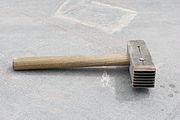Riffelhammer
The Riffelhammer is used by stonemasons to level a surface or to create a special surface structure. After machining, the surface is given a groove-shaped structure by striking a hammer, as can be seen from the hammer head. The corrugated insert is made of hard metal and can be exchanged.
There are also bits which have a corrugated working surface and hammers are driven. The work surfaces are correspondingly small.
A special form is the “Dötzer”, also “American” or “Patenthammer” , which is used in the Southeast Eifel for processing tephritic lava (trade name basaltic lava ). In contrast to the first-mentioned form, the head is not replaced here, but the hammer consists of individual plates that are held together by four screws. This allows the hammer to be dismantled and the individual cutting edges can be re-sharpened by the blacksmith. The names “American” and “Patenthammer” indicate the origin of the tool: in 1831 a Mr. Joseph Richards from Philadelphia applied for a patent for such a tool.
Similar tools
jobs
See also
literature
- Brayley, Arthur W .: History of the granite industrie of New England. Boston (Mass.) 1913, chapter 4.

